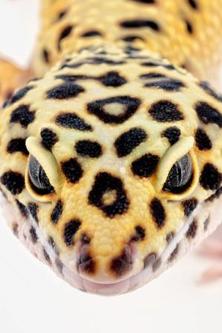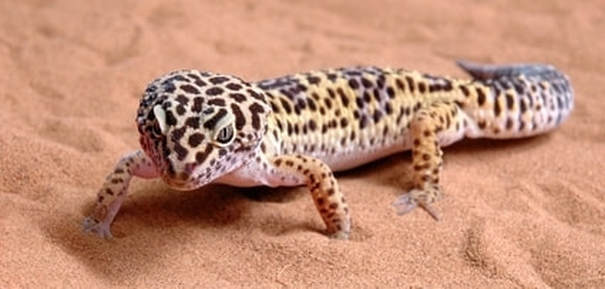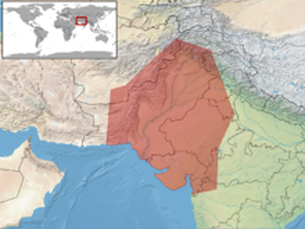Leopard GeckoEublepharis macularius |

Custom Search
|
To avoid the extreme summer heat of their natural environment during the day, they are a nocturnal or crepuscular species spending daytime under rocks or in small caves, rock crevices or burrows.
This also helps them to avoid predators such as foxes, birds of prey, snakes or other larger reptiles.Their lifespan in captivity is about 20 to 25 years, but in the wild is probably much less. In the winter when the temperatures get too low (10 °C / 50 °F) they will go underground into brumation and live off the fat reserves found in their tails. Unlike most gecko species, the leopard gecko has movable eyelids, but it lacks the adhesive lamella found in other wall-climbing gecko species. Instead, they have tiny claws and although they cannot climb up smooth vertical surfaces. But these are an obvious advantage in the sandy habitats in which the species is found. This also means the leopard gecko primarily lives on the ground and doesn't climb very often.
The leopard gecko is the largest gecko species with adult male specimens reaching 8 to 11 inches in length and weigh 60 to 80 grams. Males are larger than females which reach only an average size of 7 or 8 inches (18-20 cm) and weigh around 50 to 70 grams.
Adult Leopard geckos coloration in the wild ranges from a yellow to brownish orange base color covered with spots on the dorsal region of the body. While juveniles are banded yellow and dark brown, this will eventually fade into their adult spotted pattern as they mature.This pattern helps to camouflage them from predators. Their ventral side is white and smooth while their dorsal side is covered with small bumps, giving them a rough texture. The Leopard Gecko has a wide and thick tail, bulky in the middle and with a pointed tip, it's normally shorter than their body length. 
Leopard geckos are able to voluntarily detach their fat tails if attacked, this is known as caudal autotomy.
After they lose their tail it can continue to twitch up to a half an hour, this allows the gecko to escape potential predators. In time the tail will eventually regenerate, although the regenerated tail will never have the same appearance as the original. Leopard geckos also have quite an unusual ear anatomy, with openings on either side of their head. It's possible to look at one ear at the right angle and see right through their head. They have short legs making them quick and agile. The Leopard gecko is capable of replacing each of their 100 teeth every 3 to 4 months. The Leopard gecko is a solitary animal with the exception of the mating season. Since the 1980's they have become quite popular as a pet in North America, and today’s captive bred leopard geckos are mostly descendants of geckos imported from Pakistan in the past. In time breeders have created many color morphs such as patternless, albino, jungle, blizzard, hypomelanistic, tangerine, or snow. They have even created a size variation with a "giant" leopard gecko morph. Unlike other exotic pets, the leopard gecko doesn't carry any disease transmissible to humans. Due to the dry environment they need, salmonella isn't an issue as with aquatic or semi-aquatic species such as the red-eared slider (Trachemys scripta elegans) if kept in poor conditions. Subspecies / Taxonomy / Etymology The species was first described by zoologist Edward Blyth in 1854 as Eublepharis macularius. The Leopard gecko generic name "Eublepharis" is a combination of 2 Greek words ("eu" and "blepharos") meaning "good eyelid", referring to the movable eyelids a trait that distinguishes them from other gecko species. While their specific name "macularius", which means "blemish" or "spot" derives from the Latin word "macula and refers to their spotted pattern. They are related to other different gecko species, like the banded geckos or the African fat-tailed gecko. Although the leopard gecko shares some similarities with other geckos placed in the family Gekkonidae, some taxonomists think they should be placed in their own family. Within their Genus, Eublepharis there are 4 other gecko species, one of which was previously considered as a subspecies of the leopard gecko. Currently, there are 5 subspecies recognized for the Leopard gecko, but not all have a common name. Leopard gecko (Eublepharis macularius macularius - Blyth, 1854) Afghan leopard gecko (Eublepharis macularius afghanicus - Borner, 1976) Eublepharis macularius fasciolatus (Gunther, 1864) Eublepharis macularius montanus (Borner, 1976) Eublepharis macularius smithi (Borner, 1981) Diet / Feeding In the wild, these geckos eat primarily insects, other small invertebrates, and fruit. They feed on roaches, moths, crickets, ants, superworms, mealworms and other insects. But they will also take snails, spiders, other small lizards, birds and their eggs and small rodents. They are also known to eat their newly shed skin probably to ingest essential nutrients or maybe to hide their scent reducing the chance of attracting predators. Wild leopard geckos use their keen sense of sight and smell to find prey, and like actual leopards do, they stalk them until they strike. This is why in captivity, most specimens will still prefer hunting their food, usually crickets, and most captive leopard geckos will refuse to eat dead prey. In captivity they will eat crickets, mealworms, wax worms, grasshoppers, locusts, springtails, or roaches, occasionally they are fed baby mice. Usually, these are dusted with calcium powder with added vitamin D3 and sometimes gut loaded In the wild if food becomes scarce, they will rely on the excess fat stored in their tails to survive. Reproduction The mating season usually occurs during the rainy season. The male leopard geckos are very aggressive towards other males entering their territory but do obviously tolerate females. During courtship males sidle alongside the female, licking her and lightly biting their side, then he will grasp her neck. If the female is receptive she will lift her tail allowing the copulation to take place. The female is able to store the male sperm for up to 15 months after mating occurs. They may produce up to 5 clutches throughout the breeding season using some of the stored sperm to fertilize each separate clutch. The eggs are visible through the female's ventral skin during their internal development. Females lay and bury their eggs in the substrate, preferably in a damp and humid environment, normally 21 to 28 days after mating. Each clutch usually consists of 2 soft and sticky eggs, measuring approximately 28 x 15 mm. Those eggs that stay soft are infertile while fertilized ones are covered with a firm, thick and leathery white membrane. The eggs hatch after an incubation period ranging from 45 to 53 days, depending on temperature and humidity in the nesting site. Like other reptiles, the incubation temperature will determine the sex of the offspring. Lower nest temperatures (26°C / 79°F) yield mostly females while in higher temperatures (32°C / 90°F) more males are born. The hatchlings possess an "egg tooth" in its snout to help them break through their eggshell, this will fall off within a day or two. They also shed their skin within 24 hours of hatching. When born the hatchlings measure about 3 to 4 inches (7-10 cm) and weigh 2 to 5 grams, and for the first week they feed on the egg yolk. After about one week, they will shed for the first time and begin to hunt for their own food. The juvenile leopard geckos have brighter colors and a stronger contrast than more mature specimens. They are also covered in a banded black and yellow pattern, instead of spots, but as they grow older these bands will separate and will develop into spots as adults. The Leopard gecko reaches sexual maturity in 1 to 3 years, and are able to breed once they reach around 35 grams in weight. Conservation status and main threats Even though they are popular pets very little is known about the leopard gecko in the wild. The leopard gecko has not yet been evaluated by the IUCN. While in the past most captive geckoes in the USA were wild-caught since the 1970's most specimens sold in the U.S. are captive-bred. Today only Pakistan allows exportation of wild caught leopard geckos to the United States.
|
Scientific classification
Kingdom: Animalia Phylum: Chordata Class: Reptilia Order: Squamata Family: Eublepharidae Genus: Eublepharis Species: E. macularius Subspecies E. macularius macularius E. macularius afghanicus E. macularius fasciolatus E. macularius montanus E. macularius smithi |


